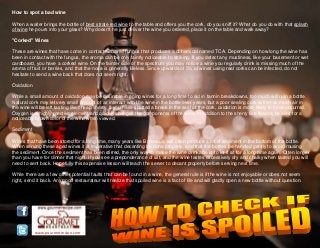
How to check if wine is spoiled
- 1. www.gourmetrecipe.com How to spot a bad wine When a waiter brings the bottle of best strate red wine to the table and offers you the cork, do you sniff it? What do you do with that splash of wine he pours into your glass? Why doesn't he just deliver the wine you ordered, place it on the table and walk away? "Corked" Wines These are wines that have come in contact with wild fungus that produces a cbhemical named TCA. Depending on how long the wine has been in contact with the fungus, the aroma can be only faintly noticeable to striking. If you detect any mustiness, like your basement or wet cardboard, you have a corked wine. On the fainter side of the spectrum you may notice a wine you regularly drink is missing much of the aroma of fruit or berries, and that the nose is generally lifeless. Since upwards of 5% of wines using real corks can be infected, do not hesitate to send a wine back that does not seem right. Oxidation While a small amount of oxidation may be desirable in aging wines for a long time to aid in tannin breakdowns, too much will ruin a bottle. Natural cork may let very small amount of air interact with the wine in the bottle over years, but a poor sealing cork will let so much air in the wine will be left tasting like cheap sherry. If you have spotted a break in the seal of the cork, oxidation is more likely to have occurred. Oxygen is a highly reactive element and quickly changes the components of the wine. In addition to the sherry like flavors, be alert for a noticeably brown color of the wine when viewed. Sediment Wines that have been stored for a long time, many years like Bordeaux, will often produce a lot of sediment in the bottom of the bottle. When serving these aged wines it is imperative that decanting be done properly, and that the bottles be handled gently to avoid rousing the sediment. Once the sediment has been stirred, the only way to make the wine drinkable is to let it sit for a long time again. Often longer than you have for dinner that night. If you see a preponderance of silt, and the wine tastes excessively dry and chalky when tasted you will need to sent back. Hopefully this expensive lesson will teach the server to decant properly before serving next time. While there are a few other potential faults that can be found in a wine, the general rule is if the wine is not enjoyable or does not seem right, send it back. Any good restaurateur will realize that spoiled wine is a fact of life and will gladly open a new bottle without question.
